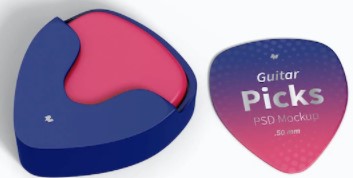
When it comes to choosing the right guitar pick thickness, there are a lot of things to consider. Depending on your playing style, you may need a different thickness than someone else.
In this blog post, we will discuss the different factors that go into choosing the right guitar pick thickness for you! We will also provide a guitar pick thickness chart to help you out.
What Is A Plectrum?
A guitar pick, also known as a plectrum, is a small, thin tool used to pluck the strings of a guitar. Available in various materials and shapes, picks influence the tone and playability of the instrument.
Plectra can be made from a variety of materials including:
- Plastic
- Celluloid
- Nylon
- Metal
- Stone
- Glass
- Wood
Each material has its own unique feel and sound. For example, a plastic pick will have a brighter sound, while a metal pick will have a warmer sound.
Plectra can also come in different shapes including:
- Teardrop
- Triangular
- Square
- Oval
- Round
The shape of the pick can also affect the sound. For example, an around pick will have a brighter sound, while a triangular pick will have a darker sound.
Why Use A Guitar Pick?

Guitar picks are used to pluck the strings of a guitar. They come in different shapes and sizes, and each one produces a different sound. The thickness of a guitar pick also affects the sound it produces.
Picks come in different thicknesses, measured in millimeters (mm). The most common thicknesses are 0.46 mm, 0.71 mm, and 0.81 mm.
0.46 mm picks are the thinnest picks available. They’re also the most popular pick size because they offer a good balance of control and speed. If you’re a beginner, or if you play lead guitar, this is a good pick size to start with.
0.71 mm picks are thicker than 0.46 mm picks, and they’re good for strumming chords. If you find that you’re having trouble getting a clear sound when you pluck individual strings, try using a thicker pick.
0.81 mm picks are the thickest picks available. They’re good for rhythm guitar, and they’re also the best choice for beginners. If you’re having trouble getting a clear sound when you pluck individual strings, try using a thicker pick.
How to Choose the Right Guitar Pick Thickness?

Selecting the ideal guitar pick thickness involves a nuanced understanding of various factors that influence tone production and playability. Considerations include:
- Playing Style: The first is the type of music you want to play. If you want to play lead guitar, then you will need a thinner pick so you can easily maneuver around the strings. If you are looking to play rhythm guitar, then a thicker pick is best so you can strum more forcefully.
- Guitar Type: The second thing to consider is the type of guitar you have. If you have an acoustic guitar, then you will need a thicker pick so you can strum without damaging the strings. If you have an electric guitar, then you can use either a thicker or thinner pick depending on your playing style.
- Personal Preference: Experimentation is key to discovering the pick thickness that feels most comfortable and responsive to your playing technique and musical expression.
- Environmental Conditions: Take into account factors such as humidity and temperature, as these can affect the flexibility and durability of guitar picks over time.
- Feedback and Feel: Pay attention to the feedback and feel of different pick thicknesses as you play, noting how they influence dynamics, articulation, and overall sound quality.
Guitar Pick Thickness Chart
| Extra heavy: > 2.29 mm |
| Heavy: 1.98 – 2.29 mm |
| Medium heavy: 1.78 – 1.98 mm |
| Medium guitar pick thickness: 1.40 – 1.78 mm |
| Light: 1.14 – 1.40 mm |
| Extra light: < 1.14 mm |
As you can see, there is a wide range of guitar pick thicknesses to choose from. The best way to figure out which one is right for you is to experiment with different picks until you find one that feels comfortable for you.
Our Recommendation Best Guitar Picks:
- Jim Dunlop Tortex Standard 0.50 mm Red Picks-36 Pack
- Dunlop Nylon Max-Grip Standard, Light Gray, 0.60mm
- PickWorld Guitar Picks (MG3D-5)
- Ernie Ball Prodigy Picks, Black, 1.5 mm
- ChickenPicks Light 2.2 mm guitar picks
Conclusion: Guitar Pick Thickness
This comprehensive guide equips you with the knowledge needed to navigate the world of guitar pick thickness effectively. If you have any questions, feel free to leave a comment below!
Frequently Ask Questions
How thick should a guitar pick be?
The ideal pick thickness varies based on individual preferences and playing styles. Experimentation with different thicknesses is recommended to find the perfect fit.
Is a thicker guitar pick better?
Thicker picks offer enhanced stability and control, making them ideal for certain playing techniques. However, the “better” pick thickness ultimately depends on personal preference and playing style.
Does the thickness of a guitar pick matter?
Absolutely. Pick thickness directly influences tone, playability, and overall performance. Understanding how thickness impacts your playing is essential in selecting the right pick for your needs.
Should I get a thin or medium guitar pick?
Both thin and medium picks have their merits, catering to different playing styles and preferences. Experiment with various thicknesses to determine which best suits your playing needs.
That’s all for the best guitar pick thickness for beginners guide. You can also check out 15 Best Grateful Dead Live Albums: Rolling Stone’s Picks and How to Draw a Guitar Step by Step Tutorial.



